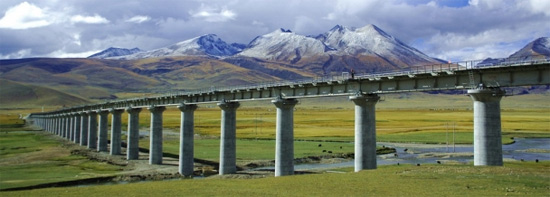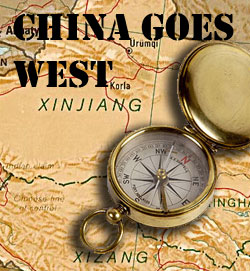Qinghai – Agriculture, Eco-Tourism, Tibet…And India?

 Aug. 27 – In my quest several years ago to obtain clients for Dezan Shira & Associates in every single province in China, it was obvious from the outset that in order to speak sensibly about each location, I would need to travel there.
Aug. 27 – In my quest several years ago to obtain clients for Dezan Shira & Associates in every single province in China, it was obvious from the outset that in order to speak sensibly about each location, I would need to travel there.
In many of the provinces, some of them far flung, I also needed to solve the not insignificant problem of generating clients that were actually interested in investing in the western regions – a subject early issues of China Briefing magazine would solve as we featured, monthly, cities that were completely off the radar some 10 to 15 years ago. That combination of good old fashioned exploration and our marketing and intelligence facilities worked, however, and we began to generate clients who were amongst some of the earliest foreign investors in the western regions.
While we had tax clients in Lhasa, representative offices set up in Lanzhou, and manufacturing WFOEs to organize in Urumqi and Nanning, Qinghai became something of an enigma. I couldn’t find any clients who wanted to go or saw any opportunities. The province, the last one in my pursuit to obtain foreign invested clients in every single Chinese province, therefore became something of a personal quest, a Holy Grail if you like. Our business and clients in the primary cities of Shanghai, Beijing and Guangzhou were booming, but it was a client in Qinghai that I really wanted.
So what does the province actually have to offer? Today’s environment is rather different from the Qinghai of 15 years ago, but let’s examine what it has, and what it offers.
Qinghai itself is an area of traditional grazing pastures with huge numbers of livestock, and was for centuries the traditional grazing grounds for Tibetan nomads. In fact, the position of the Dalai Lama was conferred on the Tibetan monk Sonam Gyatso by the Mongol Ruler Altan Khan on the banks of Qinghai Lake in 1578. In more recent years, aided by the central government’s “Go West” policy and mineral wealth, it has seen strong growth due to large oil and gas deposits. Something of a province among the clouds, more than half of Qinghai’s land rises 4,000 to 5,000 meters above sea level.
Fast facts
- China’s fourth largest province
- Qinghai Lake is the largest in China
- It is the source of China’s largest rivers; the Yangtze, Mekong, and Yellow River all originate from the province
- The capital city Xining is the key hub for the Qinghai to Tibet railway
- In terms of contemporary China, Qinghai was a frontier territory for centuries, part of the old Tibetan province of Amdo, but as borders waxed and waned between Tibetan warlord monks and the Chinese military over these periods, Qinghai was only officially incorporated into China in the 18th century, and was made a province in 1928; the construction of the rail link to Lanzhou has strengthened the connections and trade with the rest of China and the province is now beginning to develop
Six national highways run through the province, totaling over 17,000 kilometers. The province is often overlooked when it comes to domestic and international trade routes, as well as development schemes, largely due to its geographic location. The main expressway in Qinghai is the 217 kilometer Xining-Lanzhou expressway, linking Qinghai directly to Gansu, which purchases much of Qinghai’s mining products for its nuclear, aerospace and reprocessing industries. Also included in China’s medium and long term railway network plans are six new rail lines for the Qinghai-Tibet railway to boost the region’s economy. It is expected that the new lines will be operational before 2020. Three of the six tracks will originate from Golmud in Qinghai and run to Chengdu in Sichuan, Dunhuang in Gansu, and Kuerle in Xinjiang. This is partly to promote Tibetan trade and tourism, but will also make Qinghai a hub for the passage for Tibetan-Chinese trade and distribution. Should the Tibetan line eventually extend to Katmandu as has been proposed, Qinghai’s cities of Golmud and Xining will have access to Nepalese markets. That is strategically important as there are also talks on the Indian side of linking up to Katmandu from the massive Indian rail network. If this happens (not yet approved, but expect a 2020 timeline) via rail at least, Qinghai will be linked to India.
Aside from links to Tibet, the major routes in and out of the province are the Lanzhou-Qinghai railway, which runs from the provincial capital of Xining to Gansu, and then on to Lanzhou; while the Qinghai-Tibet railway also has a direct link to Shanghai and Beijing . In terms of trade, this line was completed in 2006, and by May 2007 had transported 1.3 million passengers and 650,000 tons of goods in and out of Tibet. It also contains a luxury Pullmann coach serviced by the Ritz-Carlton.
The main airport is the Xining Caojiabu Airport, a 4D grade airport, which has routes to Beijing, Xi’an, Shanghai, Guangzhou, Chengdu and Lanzhou as well as other domestic destinations. Golmud Airport is also expecting more passengers after the opening of the Qinghai-Tibet railway which passes through Golmud. Previously, the airport had to be closed due to low demand. In early 2007, the government announced plans to build another airport at Shangbatang in southwest Qinghai. The RMB478 million project will be capable of handling 80,000 passengers by 2015.
Qinghai’s economic and investment climate has improved and grown rapidly since 2001 to reach a GDP of RMB108.1 billion in 2009. Year-on-year growth has not fallen below 12 percent in that time. Secondary industry has been the main driver of growth, accounting for 52.1 percent of all economic activity in the province in 2008.
Key industries in the province include agriculture, hydropower, salt-chemical, non-ferrous metals, and oil and natural gas. Industrial enterprises are centered at Xining, Golmud and the Qaidam Basin which is an important source of raw materials to the province’s heavy industries (potassium, magnesium, lithium, natural gas, and crude oil). Estimated reserves of oil are 1.2 billion tons, of which 0.22 billion tons have been proven to exist. The Qaidam Basin gas field, at 293.7 billion cubic meters, is the fourth largest in the country. Out of the 125 types of mineral reserves discovered in Qinghai, 54 are among China’s top 10 largest reserves. The 33 salt lakes in Qiadam Basin are rich in high quality sodium, potassium, magnesium and lithium. Total reserves are estimated to be 70 billion tons. Qinghai also has a major livestock trade, with 31.6 million hectares of usable grassland and over 23 million various kinds of livestock. Meat and fur producing industries are a major part of the agricultural economy.
The province has the potential to be one of the largest hydropower bases in China. There are 270 relatively large rivers flowing through the province, of which over 100 have the potential to generate more than 10,000 kilowatt hours, totaling a potential of 19.04 billion kilowatts and an annual output averaging 55 billion kilowatt hours. A total of 178 sites are capable of generating 21.65 million kilowatt hours. The cost of building a power station in Qinghai is 20 to 40 percent cheaper than the rest of the country. The total installed capacity of power generation has amounted to 6.88 million kilowatts with an annual output of 27.64 billion kilowatt hours.
Utilized FDI in 2009 amounted to US$220 million. Exports reached US$419 million in 2008 while imports increased to US$270 million. The Qinghai-Tibet railway greatly boosts the province’s chances of seeing some much needed cash-flow from tourism. It is expected that around 800,000 more people will travel through Qinghai because of the railway. However, because of Tibet’s restricted access to foreigners, the potential of overseas tourism remains largely untapped, although the route has proved extremely popular with domestic tourists.
The largest and only state-level development zone in Qinghai is Xining Economic and Technological Zone. Other provincial owned development zones include Haixi Eastern Economic Development Zone, established in 2001 and located near the city of Delingha, and Qiaotou Economic Development Zone which is devoted mainly to chemicals, building materials, non-ferrous metals, machine manufacturing, coal and power.
Golmud Kunlun Economic Development Zone
Established in 1992, GKEDZ covers an area of 28 square kilometers. The zone, based in Golmud, aims to exploit the natural resources at the nearby Charhan Salt Lake as well as the rare stone materials in nearby Kunlun Mountain. The reserves of all kinds of lake salt amount to more than 60 billion tons. The zone has a salt chemical base with over 100,000 t/a capacity of potassium and magnesium products. The nearby Kunlun Mountains contain large reserves of high quality, rare stone materials which would be tapped by a large stone material processing park in GKEDZ. This project would bring an estimated income of RMB462 million and a yearly profit of RMB3 million once it is in operation.
Eco-tourism is also being developed here and the local government has become concerned with degradation and is supporting eco-friendly projects to develop the tourism industry in an environmentally supportive manner.
While Qinghai remains a remote location for many, opportunities are there. I was able to obtain a client in the province, originally some due diligence work that has now expanded into a handful of corporate establishments, and some tax work. Mining, minerals and rare earths, support services and products for the rail network expansion, as well as in eco-tourism are all prime sectors for FDI. Qinghai remains enigmatic, but is still a great location to travel to, both culturally and for certain investment projects.
Parts of this article were excerpted from the China Briefing Guide to West China
Chris Devonshire-Ellis is the principal and founding partner of Dezan Shira & Associates, establishing the firm’s China practice in 1992. The firm now has 10 offices in China. For advice over China strategy, trade, investment, legal and tax matters please contact the firm at info@dezshira.com. The firm’s brochure may be downloaded here. Chris also contributes to India Briefing , Vietnam Briefing , Asia Briefing and 2point6billion
Correction, August 30, 2010
An earlier version of this article incorrectly identified Kublai Khan as the Mongol ruler who conferred the title of Dalai Lama onto Sonam Gyatso. It was Altan Khan.
Related Reading
The Complete “China Goes West” Series
(Covering all of China’s western regions and their investment potential)
Xining City Guide
(Complimentary PDF download)
Business Guide to West China
(Includes overviews of the Provinces of Gansu, Guizhou, Ningxia, Shaanxi, Sichuan, Tibet, Xinjiang and Yunnan, and includes detailed introductions to the key cities of Chengu, Chongqing, Kashgar, Kunming, Lanzhou, Lhasa, Guiyang, Urumqi, Xi’an, Xining and Yinchuan)
- Previous Article Chinese Exporters Owed US$150 Billion
- Next Article Ningxia to Host China-Arab States Trade Forum











